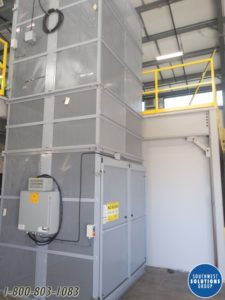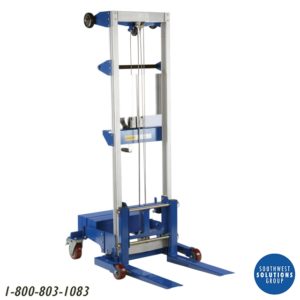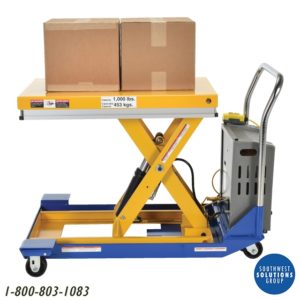
Businesses want their items shipped promptly and stored correctly, mandating the use of innovative storage solutions. On top of that, your warehouse will also be operating in high volumes.
All these factors add up to a demand for quality warehouse equipment, and a critical piece of equipment in your warehouse is the lift. Lifting equipment is one of the most vital material-handling components in a warehouse. Industrial lifts for warehouses may include the entire range of stackers to forklifts. Along with other machines, such as trucks or docks, lifts help you operate your warehouse effortlessly. The right lifts and other equipment will additionally ensure worker safety, efficiency, and ease of management.
Southern Representatives Warehouse Lifts
Warehouse lifts are industrial lifts supported by southern representatives, for the material handling, industrial, dock & door, and packaging markets. Some of the popular warehouse lift systems offered by us include:
Vertical Lifts
Vertical lifts or freight lifts typically move goods from one floor to another. If you need a lift to carry a heavy load of goods between different levels at your warehouse, vertical lifts offer a safe option. This type of lift is advantageous when the goods are not palletized. Whether you are setting up your warehouse from scratch or scaling and renovating, vertical lifts can help you achieve vertical lifting of goods between levels. Retrofitting a vertical lift into existing warehouse spaces is also possible.
You can also get a freight elevator custom-designed for your warehouse. The custom-made designs consider factors such as the required dimensions, expected load that needs to be carried, and whether loading operations will be mechanized or by hand.
Scissor Lifts
Scissor lifts hoist the materials up to precise working heights with particular attention to the productivity and safety of the operating staff. Scissor lifts also come in specially designed lift tables and turntable lifts to allow workers to perform material handling operations quickly and safely. Turntable lifts achieve this by facilitating the turning of the materials at any angle after lifting.
These warehouse scissor lifts do not require docks for loading or unloading trucks. Together, these machines provide ergonomic equipment and reduce safety hazards for your workers.
Dock Lifts
Dock lifts find operation in loading docks where different types of trucks or trailers are accessible. These lifts elevate the trailers to the dock height accounting for the varying and non-standardized height of the trucks themselves, making the load easy to handle.
All of the listed lifts contribute to making warehouses safer and faster work environments. Dock lifts are no exception.
Forklifts

This electric warehouse lift facilitates vertical maneuvering and driving around for loading, unloading, or carrying goods, making them indispensable to warehouses and other extensive storage facilities requiring mechanized material handling support. Some of the larger lifts also come with side shifters and tiltable masts to handle the materials.
Forklifts can be electrically powered through a battery or a small combustion engine. Based on the extent of use, ergonomic designs are available for both standing and seated operation. The extensive range of forklifts based on load carrying and dimensions are available, encompassing standing operations to heavy-duty trucks.
Forklift sizes may vary from one ton up to 50 tons, though the capacity for general warehouse-related work is typically under a ton. A plate on the forklift determines the highest weight it can lift.
Benefits of Warehouse Lifts
Warehouse lifts are beneficial in many ways helping you handle different types of loads. You might be needing specialized lifts for heavier loads, making the load capacity one of the factors when deciding which lifts to opt for. There are many other circumstances where you will inevitably need an industrial lift. You might consider flexibility or maneuverability and ease of storage while deciding on your lift options.
In all cases, you would benefit from lifts that are easy to operate, intuitive or with a slight learning curve, and ergonomically designed. Different types of warehouse lifts offer a range of benefits. Let us look at a few.
Increased Safety
Warehouses are one of the most hazardous places to work, no matter how experienced your employees are. The transportation and warehousing industries have one of the highest nonfatal injury rates of any sector. These accidents typically come from overexertion or falls. With lifting and carrying heavy objects almost every day, your workers are at high risk of injury due to continuous strain not just on their muscles and ligaments but also on their blood vessels. Vertical material lifts can help prevent these strains as well.
Scissor lifts can reduce the chances of injury while working at heights and are a significant upgrade from ladders by offering additional stability. They are also equipped with guardrails, heavy bases, and spacious platforms to minimize the chances of a fall. On the other hand, a worker will benefit from a scissor lift at lower heights by avoiding injuries due to reaching too high. Scissor lift tables provide a platform to grab items beyond reach without strain, helping workers avoid common muscular or skeletal injuries.
A freight lift is advantageous while transporting goods between floors and provides a safe way for transportation by eliminating the chances of accidents and injuries, unlike boom lifts, forklifts, and scissor lifts. The problem is that scissor lifts can get off balance and knocked down, while freight lifts can only move up and down. They also have a higher weight load capacity and provide structural support.
Increase Efficiency and Productivity
The efficiency of your workforce deteriorates towards the end of their shifts due to fatigue. Their bodies cannot keep up, and they cannot move the items at the same rate. Material lifts can help fix that by providing mechanized support that can function simultaneously throughout the day, providing all-day efficiency.
Scissor lifts come with elevation controls that offer precise height adjustments compared to rungs on a ladder. They help the workers maintain an optimal height while performing storage operations. As a result, you get lower material handling times and create higher productivity levels for your workforce.
Using a freight lift, you can even reduce labor hours while maintaining or improving warehouse efficiency while transporting items between floors.
While it might seem trivial to consider a minor height adjustment as an essential feature, imagine the number of times a worker would have to lean or crouch or reach up higher on a ladder and consider that as a multiplicative factor. With repeated unhealthy movements and posture, the worker might suffer from severe fatigue or even ailments and injuries. The right industrial lifts for warehouses can reduce this strain, helping your average worker work faster for more extended periods while avoiding any major health hazards. Warehouse lifting equipment makes a warehouse more efficient and productive. It further helps you streamline your operations.
Enhanced Ergonomics
We already discussed that scissor lifts help reduce strain-related issues by providing higher precision. By reducing bending and twisting, these lifts offer an ergonomic advantage and help workers undergo fewer injuries or work fatigue.
But modern lifts don’t stop there. Today, the key to employee satisfaction is comfort, and it applies to warehouses as well. It is a general belief that happy workers are more productive.
Ergonomics in industrial equipment involves attention to important details such as comfortable grips or the placement of switches.
How to Use Southern Representatives Warehouse Lifts
Warehouse lifts offered by manufacturing partners at Southern Representatives are easy and intuitive to operate. Anyone with a basic orientation can safely and effectively operate these lifts. The controls are like any other lift, and a seasoned warehouse worker should not face any barriers while transitioning from their old workplaces. The warehouse environment will itself be familiar to operate by making the use of appropriate shelving.
For example, stackers can be hand or foot-operated and have the option for electrical operation. Scissor lifts come with a push-button operation along with a hydraulic valve and can have the additional option to limit the height raised. Some models may have the provision for a footswitch.
How Southwest Solutions Group Can Help
We believe that the right industrial storage equipment can improve warehouse operations. Southwest Solutions can help you procure equipment for maintaining a well-organized warehouse to facilitate a successful warehousing business.
Our innovative high-density storage solutions, such as compact pallet racks, can further help in doubling your warehouse storage space. With just a push of a button on the control panels located on the row ends, workers can quickly move rows of these pallet racks to create moving aisles while maintaining 100% selectivity when and where needed.
Contact us for more information on Southern Representatives’ warehouse lifts or design assistance for your warehouse storage.





